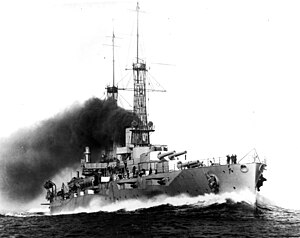
Back Линейни кораби тип „Ню Йорк“ Bulgarian Třída New York Czech New-York-Klasse German Clase New York Spanish New York -luokka Finnish Classe New York French אוניות המערכה מסדרת ניו יורק HE Classe New York Italian ニューヨーク級戦艦 Japanese Pancerniki typu New York Polish
 New York, the lead ship of the class, shortly after entering service in 1915
| |
| Class overview | |
|---|---|
| Name | New York-class battleship |
| Builders | |
| Operators | |
| Preceded by | Wyoming class |
| Succeeded by | Nevada class |
| Built | 1911–1914 |
| In commission | 1914–1946 |
| Planned | 2 |
| Completed | 2 |
| Retired | 2 |
| Preserved | 1 |
| General characteristics [1] | |
| Type | Super-dreadnought battleship |
| Displacement | |
| Length | |
| Beam | 95 ft 2.5 in (29.020 m) |
| Draft |
|
| Installed power |
|
| Propulsion | 2 × screw propellers; 2 × triple-expansion steam engines |
| Speed | 21 kn (39 km/h; 24 mph) |
| Range | 7,060 nmi (13,080 km; 8,120 mi) at 10 kn (19 km/h; 12 mph) |
| Complement | 1,042 officers and men |
| Sensors and processing systems | |
| Armament |
|
| Armor | |
The New York class was a pair of super-dreadnought battleships built for the United States Navy between 1911 and 1914. The two ships of the class, New York and Texas, saw extensive service beginning in the occupation of Veracruz, World War I, and World War II.
Designed as a more heavily armed improvement over the previous Wyoming class, the New York class was the first battleship to feature the 14-inch (356 mm)/45 caliber gun and the first American super-dreadnought, but was one of the last battleship classes designed with a five-turret layout and coal for fuel. The class also suffered several deficiencies such as a lack of anti-aircraft weaponry and armor layout, which were addressed with the subsequent Nevada class. Because of these deficiencies, both ships saw several extensive overhauls over the course of their careers which greatly changed their appearance.
Both New York and Texas entered service in 1914 and immediately served in the occupation of Veracruz, and service reinforcing the Royal Navy's Grand Fleet in the North Sea during World War I, during which time New York is believed to have sunk a U-boat in an accidental collision. Both ships undertook numerous training exercises and overhauls during the interwar era, and joined the Neutrality Patrol at the beginning of World War II. Outmoded by more advanced battleships in service, both ships served primarily as convoy escorts and naval artillery during the war. New York supported Operation Torch in North Africa, undertook convoy patrols and training in the Atlantic, and supported the Battle of Iwo Jima and the Battle of Okinawa. Texas supported Operation Torch, Operation Overlord, the bombardment of Cherbourg, Operation Dragoon and the battles at Iwo Jima and Okinawa. Following the war, New York was used as a target ship in Operation Crossroads and sunk as a target in 1948, while Texas was converted into a museum ship, and was moored in San Jacinto State Park until being moved to a drydock in Galveston, Texas in August 2022 for restoration operations.
- ^ Gardiner & Gray 1985, p. 115.